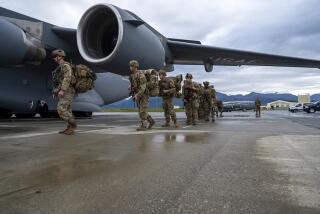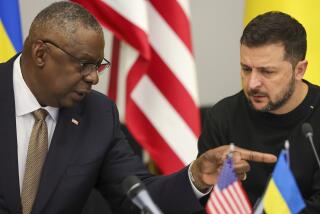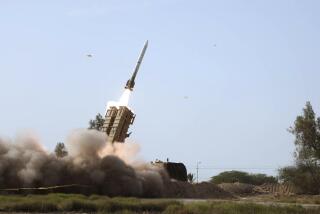U.S. Sees Soviet Breach in Afghan Air Buildup : Says Backfire Bombers and MIG-27s Violate Moscow’s Pledge to Avoid Offensive Actions
- Share via
WASHINGTON — The Soviet Union, breaching a pledge to avoid offensive military action during its withdrawal from Afghanistan, has launched its powerful Backfire bombers against moujahedeen insurgents in the vicinity of the provincial city of Kandahar, the Reagan Administration said Monday.
State Department spokesman Charles Redman said that the Backfires, based in the Soviet Union, began bombing raids against the moujahedeen within the last day or two. The use of the long-range, swing-wing bombers followed the deployment of about 30 Soviet MIG-27 fighter-bombers to Afghanistan earlier in October.
“We view this augmentation of Soviet firepower in Afghanistan with grave concern,” Redman said. “Such actions are inconsistent with Soviet undertakings not to conduct offensive operations except in defense of their own forces.”
Supporting Afghan Army
Redman said that the latest Soviet air action is in support of the Afghan army, which is attempting to hold the Kandahar area, in southern Afghanistan, against a moujahedeen advance. He said that Soviet ground forces already have been withdrawn from the region.
The U.S.-supported moujahedeen are trying to overthrow the Soviet-backed Afghan government.
Redman said the Soviet government earlier promised the United States that it would use its military power only to protect its own troops during their withdrawal, which is scheduled to be completed by Feb. 15. In exchange, the United States urged the moujahedeen to forgo attacks on the retreating Soviet forces.
Redman said that Undersecretary of State Michael H. Armacost protested the Soviet action to Ambassador Yuri V. Dubinin on Monday during a meeting that had been scheduled earlier for a broad review of U.S.-Soviet relations.
The Backfire is the mainstay of the Soviet heavy bomber force. Although it lacks intercontinental range, it is capable of carrying massive loads of bombs on relatively short missions like the sorties into Afghanistan. Until Monday, the plane had not been reported used in Afghanistan.
First Official Confirmation
Moujahedeen leaders told a press conference last week that about 30 MIG-27s have been deployed near Shindand, in western Afghanistan about 250 miles northwest of Kandahar, the previous week. The New York Times reported the deployment late last week, but Redman’s comments Monday marked the first official U.S. confirmation of the reports.
In the Geneva accords signed last April by Afghanistan, Pakistan, the Soviet Union and the United States, Moscow agreed to withdraw all of its estimated 115,000 troops from Afghanistan by next Feb. 15. The pact called for removal of half of the troops by last Aug. 15, a deadline that the United States agrees the Soviets met.
Soviet Foreign Minister Eduard A. Shevardnadze, talking to reporters last month at the United Nations, accused Pakistan of violating the Geneva agreement by providing military assistance to the moujahedeen . He hinted that Moscow might reverse its decision to pull back its troops unless Pakistan ended its support for the rebels.
Continued U.S. Support
At the time he signed the Geneva agreement, Secretary of State George P. Shultz said the United States would continue supporting the moujahedeen as long as Moscow provided military assistance to the Afghan army.
Although Soviet spokesmen acknowledge that the rebels’ weapons are coming from the United States, Moscow has not formally accused Washington of violating the pact, probably because Shultz served notice of the U.S. position. Instead, the Soviets have directed all of their accusations at Pakistan, which did not issue a formal statement similar to the Shultz declaration.
More to Read
Sign up for Essential California
The most important California stories and recommendations in your inbox every morning.
You may occasionally receive promotional content from the Los Angeles Times.










